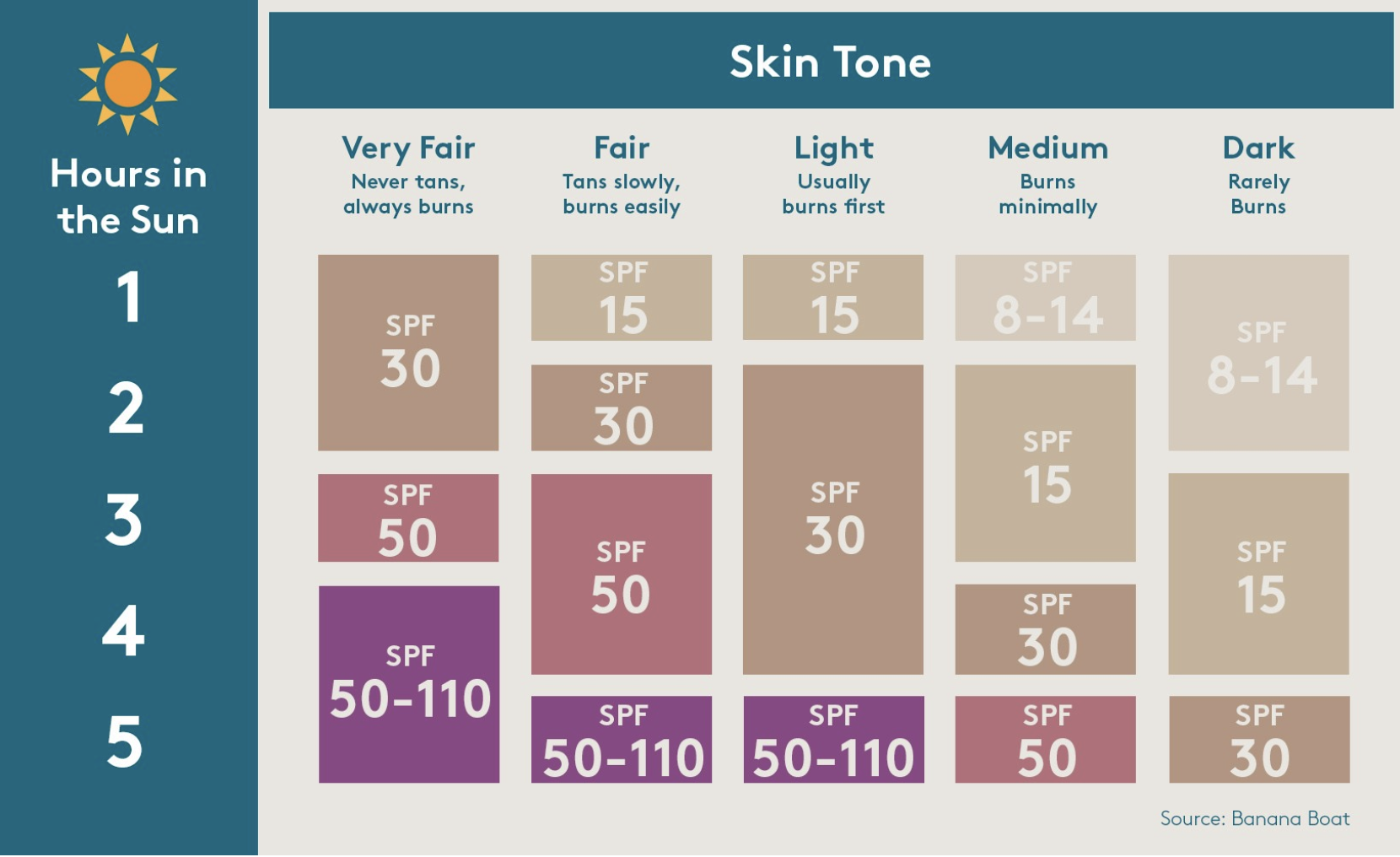By MotivHealth
What are UV Rays?
July is National UV Safety Awareness month. We’ve all heard the term “UV ray” a thousand times, but what exactly is a UV ray? UV stands for ultraviolet. The sun (as well as manmade tanning beds) emits electromagnetic radiation called ultraviolet rays. Radiation is defined as the emission of energy that spreads out as it travels. There is an entire spectrum of electromagnetic radiation which ranges from low-frequency radio waves to high-frequency gamma waves. Ultraviolet light sits toward the higher frequencies on the spectrum, just above visible light and below x-rays.
Don’t Our Bodies Need Sunlight?
Ultraviolet rays are essential because they cause our bodies to produce vitamin D which allows us to absorb calcium and phosphate in order to strengthen our bones. However, the saying, “Too much of a good thing is a bad thing,” might be more applicable to UV rays than anything else. The truth is that you only need five to fifteen minutes of sun exposure two to three times a week to fulfill your vitamin D needs, and UV rays are a known carcinogen. However, just because that’s all the sunlight you need doesn’t mean you can’t expose yourself to UV rays for longer. It means that you must take very particular measures to protect yourself from the sun—and in a month as hot as July, one application of sunscreen isn’t going to cut it. 3.3 million Americans are diagnosed with skin cancer each year. More than 419 thousand of these diagnoses are linked to indoor tanning.
The beauty industry loves to say that tanning produces a “healthy glow.” Ironically, the “healthy” glow that appears after UV exposure is actually a result of skin damage. Your skin cells produce melanin in an attempt to protect themselves from further sun damage. Knowing this, we should eliminate the stigma surrounding spray tans—be proud of your fake glow! It’s much healthier than a real tan. Also, just because you don’t tan or burn doesn’t mean you’ve escaped sun damage altogether. Prolonged exposure to UV rays can actually alter your DNA. These alterations lead to cancer which can hide for a long time.
Wear Sunscreen!
The number one way to protect your skin from UV rays is sunscreen. There are two categories of sunscreen: physical and chemical. Physical sunscreens are thick and prevent UV rays from touching the skin. Chemical sunscreens are thinner and turn UV rays into non-damaging rays. A variety of both physical and chemical sunscreens are sold at most drug stores. Click here to learn about the pros and cons of each. It is alarming how many people leave their houses on a daily basis without applying sunscreen first. Sunscreen is not just for the summertime, sunny days, and the outdoors. UV rays still exist in cold weather, and they penetrate through clouds and windows. Sure, your skin is more likely to be damaged at noon on the beach in July than on a December morning in the office, but the sun is always there. 90% of aging can be attributed to the sun. If an elixir for eternal youth exists, we guarantee that its first ingredient is sunscreen. Put sunscreen on every morning before you leave the house. There’s not much use in putting sunscreen on your arms and legs during fall and winter when they’re covered up, but there’s never an excuse to leave sunscreen off of your face. For those with sensitive skin, make sure to purchase non-comedogenic sunscreen, preferably mineral based. This should not clog your pores or trigger breakouts.* Since sunscreen doesn’t taste great, make sure to buy a lip balm with SPF (sun protection factor) as well. For most people, it is recommended to always wear sunscreen with SPF 30 or higher. The chart below shows which SPF is best for you.

(The image above is from colorescience.com.)
Did you know that sunscreen only delivers its full effect for two hours? This means that it must be reapplied several times throughout the day. This may seem especially alarming for those who wear makeup regularly. The good news is that there are tricks for reapplying sunscreen over makeup. Click here to see Michelle from Lab Muffin Beauty Science show you a few of these tips.
Protect Your Eyes
Your skin is not the only body part susceptible to UV damage. UV rays can severely damage your eyes. The eyes are made up of some of the most sensitive tissues in the entire body. UV rays can easily penetrate your corneas and cause cataracts, among other diseases. You may be thinking, “Well, I’m not going to put sunscreen on my eyeballs…” and we agree with you. Please don’t apply sunscreen to your eyes. Wear sunglasses—they weren’t invented just to make you look cool. Not all sunglasses are created equally. If you happen to have a UV light laying around the house, there is a simple test you can perform on your shades to see how effective they are: When you shine a UV light on (newer) US paper currency you’ll notice that certain fibers will glow. Hold your sunglasses directly in front of the money and shine the UV light on the lenses. If the fibers in the bill still glow then your glasses aren’t protective enough. We realize that most people don’t own UV lights. You can also take your sunglasses to your local eye doctor. Most optometrists are willing to perform a quick, free test to determine whether or not your sunglasses are protective enough. Many older sunglasses receive their UV protection from a coating on the outside of the lenses. Make sure to replace sunglasses such as these if the lenses get scratched.
Can UV Damage Be Reversed?
So, what if you forget to reapply sunscreen and you get burned? Worse yet, what if you’ve spent the last decade indulging in indoor tanning? Is it too late for you? Let’s start with sunburns. First, take a cool bath or shower to relieve some of the pain. Then apply moisturizer that contains aloe vera or soy. You can take ibuprofen or aspirin to diminish some of the pain and swelling. Drink more water than usual—it’s essential to stay hydrated after a sunburn. While the sunburn is healing, make sure you do not pop any blisters. Cover the burned area with clothing when you go outside, even if the weather is hot. It’s better to sweat a little than to worsen the skin damage.
Now, the ultimate question: is there a way to reverse long-term sun damage? Dermatologists’ number one recommendation for sun-damaged skin is vitamin A. Vitamin A is found in retinol creams.* Retinol penetrates the outer layer of your skin and enters the middle layer. There, it promotes your body’s production of collagen and helps keep your pores unclogged. Retinol also exfoliates your skin which allows you to shed dead and damaged skin faster than normal. Over time, it can help diminish the appearance of fine lines and wrinkles. Be aware that retinol typically makes the skin flaky and can even cause breakouts for the first 2-12 weeks of use, but the long-term results are usually well worth it. It is a good idea to wait a day or two between applications when you first start using retinol. Retinol makes your skin more sensitive to UV rays so it is recommended to apply it at night, then apply sunscreen as soon as you wake up in the morning. And don’t forget to reapply your sunscreen!
In addition to retinol, lasers* can also help reverse sun damage. Sun spots can generally be lasered away. Lasers can also help treat the tiny broken blood vessels that often result from sun damage. Lasers can even be used to purposefully cause mild damage to the skin that ultimately promotes healing and the production of collagen and healthy skin cells.
Of course, it is always better to prevent UV damage than to treat it. Wear your sunscreen!
*Be sure to consult your dermatologist before choosing sunscreen (particularly if you have sensitive skin), using retinol, or going in for laser treatment. Each person’s skin is unique and can react unexpectedly to various products and treatments.
What is your favorite brand of sunscreen? Comment below.
Sources
“Chemical vs Physical Sunscreen: The Facts”
La Roche Posay
“How Does Sunscreen Work to Protect Your Skin?”
Colorescience
“How Does Retinol Work on the Skin?”
Kristeen Cherney
“How Does Ultraviolet Light Damage Your Eyes?”
Nevada Eye Physicians
“How Long Does Sunscreen Last?”
Hilary Brueck
“How to Reapply Sunscreen Over Makeup”
Lab Muffin Beauty Science
“How to Test if Sunglasses are UV Protected?”
All About Vision
“How to Treat Sunburn”
American Academy of Dermatology
“Is It Possible to Reverse Sun Damage?”
Ali Venosa
“Should We Fear the Sun? What is a Suntan?”
Radiation Safety Institute
“Skin Cancer: Causes, Symptoms, and Treatments”
Cancer Treatment Centers of America
“Skin Cancer Facts and Statistics”
Skin Cancer Foundation
“The Electromagnetic Spectrum”
NASA
“This One Thing Slows Aging by 90%”
QSun Editorial Team




No Comment